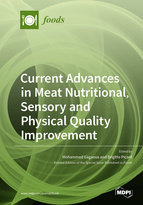Current Advances in Meat Nutritional, Sensory and Physical Quality Improvement
A special issue of Foods (ISSN 2304-8158). This special issue belongs to the section "Meat".
Deadline for manuscript submissions: closed (31 August 2019) | Viewed by 67945
Special Issue Editors
Interests: meat; skeletal muscle; beef quality; proteomics; muscle biochemistry; muscle fibres; muscle development; sensory quality; biomarkers of meat quality; prediction of meat quality; rearing practices and beef quality
Special Issues, Collections and Topics in MDPI journals
Interests: meat science; muscle and meat biochemistry; biomarkers of meat quality; foodomics; novel strategies to improve meat quality; meat tenderization; meat products; rearing practices and beef quality
Special Issues, Collections and Topics in MDPI journals
Special Issue Information
Dear Colleagues,
Meat is an important source of proteins, vitamins, minerals and fat, and these nutrients are important for their beneficial effects on human health. In recent years, meat quality has become a more relevant topic for consumers with regard to health and sensory characteristics and for beef industry stakeholders because it affects their profitability. Despite the efforts of beef sector actors to control the eating and nutritional quality of beef, there remains a high level of variability in these quality traits, which is one reason for consumer dissatisfaction. However, it is recognized that science and innovation would play a great role in helping the industry respond to consumer concerns and expectations. This Special Issue deals with the continuum aspects, i.e., from farm to fork, that would have an impact on the nutritional, sensory and technological aspects of carcass, muscle, meat and meat-products qualities. It deals also with the new developments and our current understanding of the biological mechanisms behind meat quality. Additive genetic variation for several beef quality traits such as tenderness, color, flavor, water-holding capacity and pH can be further addressed in this special issue, and hence selection strategies that could be easily implemented are strongly welcomed. In this special issue, we aim at publishing innovative research results and review papers on physicochemical characteristics, sensorial characteristics, nutritional value, functional and technological properties; as well as prediction of carcass and meat sensory qualities, adopting chemometrics, multi-variate and statistical data analysis approaches. Finally, this Special Issue seeks to provide a fundamental understanding and the current strategies to improve the nutritional, sensory and physical properties of meat.
Dr. Brigitte Picard
Guest Editor
Dr. Mohammed Gagaoua
Co-Guest Editor
Manuscript Submission Information
Manuscripts should be submitted online at www.mdpi.com by registering and logging in to this website. Once you are registered, click here to go to the submission form. Manuscripts can be submitted until the deadline. All submissions that pass pre-check are peer-reviewed. Accepted papers will be published continuously in the journal (as soon as accepted) and will be listed together on the special issue website. Research articles, review articles as well as short communications are invited. For planned papers, a title and short abstract (about 100 words) can be sent to the Editorial Office for announcement on this website.
Submitted manuscripts should not have been published previously, nor be under consideration for publication elsewhere (except conference proceedings papers). All manuscripts are thoroughly refereed through a single-blind peer-review process. A guide for authors and other relevant information for submission of manuscripts is available on the Instructions for Authors page. Foods is an international peer-reviewed open access semimonthly journal published by MDPI.
Please visit the Instructions for Authors page before submitting a manuscript. The Article Processing Charge (APC) for publication in this open access journal is 2900 CHF (Swiss Francs). Submitted papers should be well formatted and use good English. Authors may use MDPI's English editing service prior to publication or during author revisions.
Keywords
- Meat and meat products
- Nutritional value of meat
- Sensory and technological quality
- Physicochemical and muscle characteristics
- Functional and biological properties
- Current tools for meat quality prediction
- Omics of meat qualities
- Biochemical markers
- Rearing practices and impact on carcass and meat
- Big-data, statistical tools and meta-analysis








